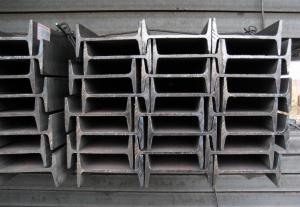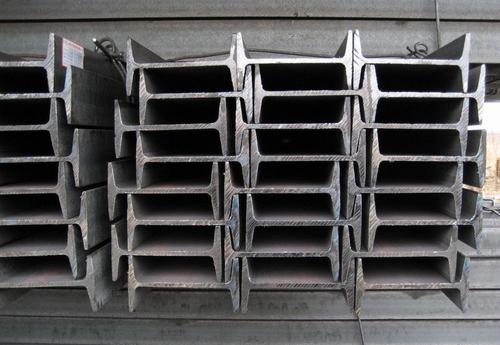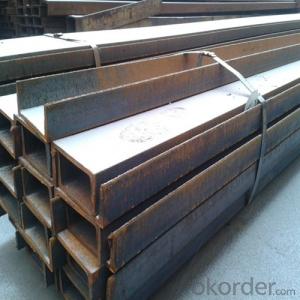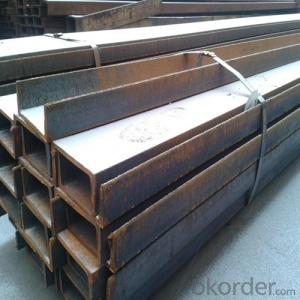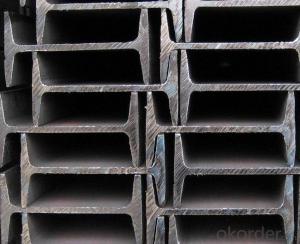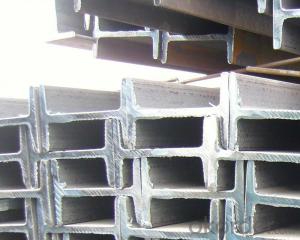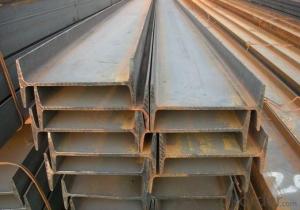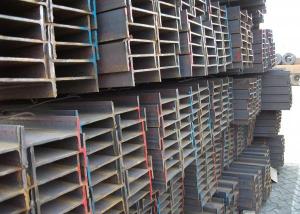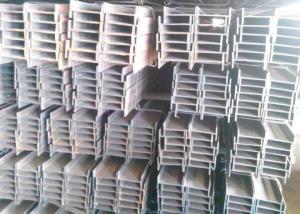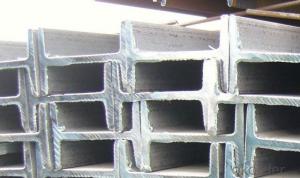IPE-Beams from Size 80-200 with Material Grade Q235
- Loading Port:
- Tianjin
- Payment Terms:
- TT OR LC
- Min Order Qty:
- 25 m.t.
- Supply Capability:
- 10000 m.t./month
OKorder Service Pledge
OKorder Financial Service
You Might Also Like
Product Description:
OKorder is offering high quality Hot Rolled Steel I-Beams at great prices with worldwide shipping. Our supplier is a world-class manufacturer of steel, with our products utilized the world over. OKorder annually supplies products to European, North American and Asian markets. We provide quotations within 24 hours of receiving an inquiry and guarantee competitive prices.
Product Applications:
1. Supporting members, most commonly in the house raising industry to strengthen timber bears under houses. Transmission line towers, etc
2. Prefabricated structure
3. Medium scale bridges
4. It is widely used in various building structures and engineering structures such as roof beams, bridges, transmission towers, hoisting machinery and transport machinery, ships, industrial furnaces, reaction tower, container frame and warehouse etc.
Product Advantages:
OKorder's Steel I-Beams are durable, strong, and resist corrosion.
Main Product Features:
· Premium quality
· Prompt delivery & seaworthy packing (30 days after receiving deposit)
· Corrosion resistance
· Can be recycled and reused
· Mill test certification
· Professional Service
· Competitive pricing
Product Specifications:
1. Invoicing on theoretical weight or actual weight as customer request
2. Standard: EN10025, GB Standard, ASTM
3. Grade: Q235B, Q345B, SS400, ASTM A36, S235JR, S275JR
4. Length: 5.8M, 6M, 9M, 12M as following table
5. Sizes: 80mm-270mm
Dimensions(mm) | |||||
h | b | s | t | Mass Kg/m | |
IPE80 | 80 | 46 | 3.80 | 5.20 | 6.00 |
IPE100 | 100 | 55 | 4.10 | 5.70 | 8.10 |
IPE120 | 120 | 64 | 4.80 | 6.30 | 10.40 |
IPE140 | 140 | 73 | 4.70 | 6.90 | 12.90 |
IPE160 | 160 | 82 | 5.00 | 7.40 | 15.80 |
IPE180 | 180 | 91 | 5.30 | 8.00 | 18.80 |
IPE200 | 200 | 100 | 5.60 | 8.50 | 22.40 |
IPE220 | 220 | 110 | 5.90 | 9.20 | 26.20 |
IPE240 | 240 | 120 | 6.20 | 9.80 | 30.70 |
IPE270 | 270 | 135 | 6.60 | 10.20 | 36.10 |
FAQ:
Q1: Why buy Materials & Equipment from OKorder.com?
A1: All products offered byOKorder.com are carefully selected from China's most reliable manufacturing enterprises. Through its ISO certifications, OKorder.com adheres to the highest standards and a commitment to supply chain safety and customer satisfaction.
Q2: How do we guarantee the quality of our products?
A2: We have established an advanced quality management system which conducts strict quality tests at every step, from raw materials to the final product. At the same time, we provide extensive follow-up service assurances as required.
Q3: How soon can we receive the product after purchase?
A3: Within three days of placing an order, we will begin production. The specific shipping date is dependent upon international and government factors, but is typically 7 to 10 workdays.
Images:
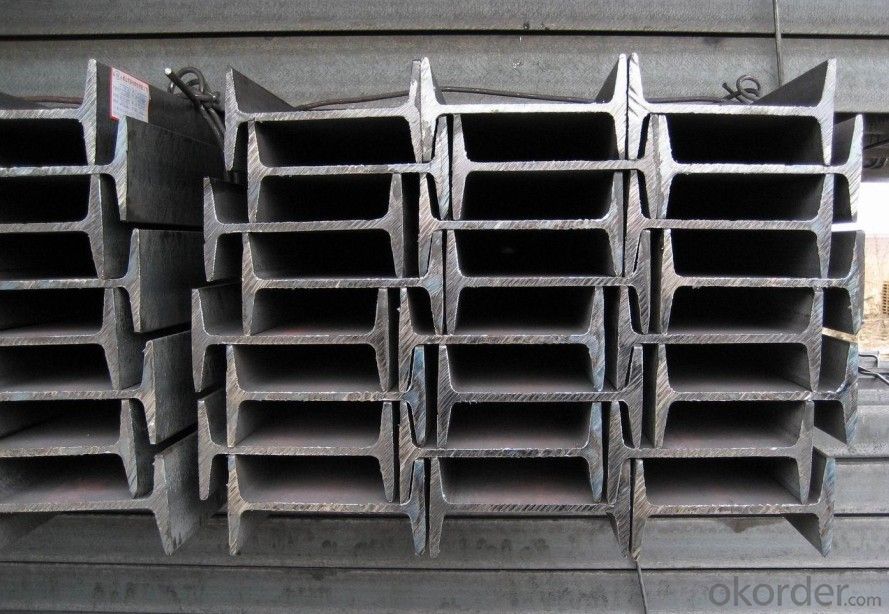
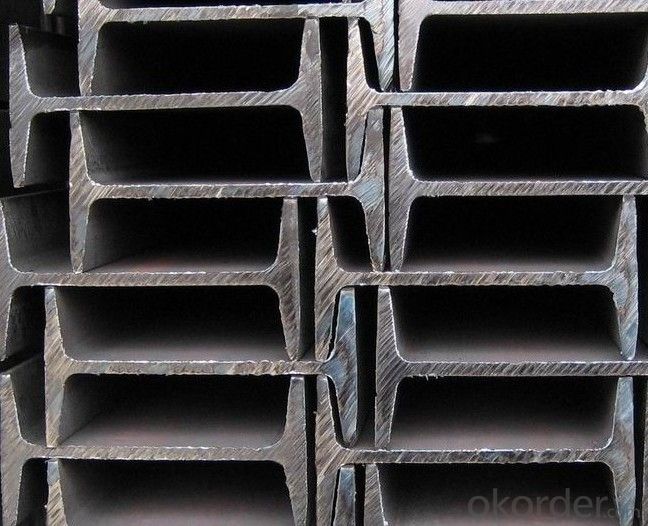
- Q: No. 11 I-beam one meter multiple
- I-beam is also called steel girder (UniversalBeam). It is a strip of steel with an I-shaped section. I-beam is made of ordinary I-beam and light i-beam. It is a section steel whose shape is trough.
- Q: Are steel I-beams suitable for agricultural or industrial buildings?
- Indeed, agricultural and industrial buildings can rely upon steel I-beams as a suitable option. Renowned for their robustness and resilience, steel I-beams prove themselves as an excellent choice for bearing substantial burdens and enduring severe weather. Their versatility extends to various agricultural and industrial uses, encompassing the support of roofs, walls, and floors, as well as providing structural reinforcement for equipment and machinery. Moreover, steel I-beams exhibit resistance against pests, fire, and decay, rendering them a durable and economically sound selection for agricultural and industrial constructions.
- Q: How do you calculate the shear force in steel I-beams?
- The shear force in steel I-beams can be calculated by determining the total load on the beam and then dividing it by the cross-sectional area of the beam. This will give the shear stress, which can then be multiplied by the area of the web of the beam to find the shear force.
- Q: What are the different types of corrosion protection methods for Steel I-Beams?
- There are several different types of corrosion protection methods available for Steel I-Beams. These methods are designed to prevent or minimize the effects of corrosion, which can weaken the structural integrity of the beams over time. Some common corrosion protection methods for Steel I-Beams include: 1. Galvanization: This is one of the most popular methods of corrosion protection. In this process, the steel beams are coated with a layer of zinc, which acts as a sacrificial anode. The zinc corrodes instead of the steel, protecting it from rusting. 2. Paint Coating: Applying a high-quality paint coating to the steel beams can effectively protect them from corrosion. The paint acts as a barrier, preventing moisture and oxygen from coming into contact with the steel surface. 3. Epoxy Coating: Epoxy coatings are often used for corrosion protection in harsh environments. These coatings provide excellent resistance to chemicals, moisture, and abrasion, thus extending the lifespan of the steel beams. 4. Powder Coating: Powder coating is another effective method of corrosion protection. In this process, a dry powder is applied to the steel beams and then heated to form a protective layer. This coating provides excellent resistance to corrosion, impacts, and UV radiation. 5. Cathodic Protection: This method involves the use of sacrificial anodes or impressed current systems to protect the steel beams. Sacrificial anodes, typically made of zinc or aluminum, are placed in direct contact with the steel surface. These anodes corrode instead of the steel, providing protection. Impressed current systems use an external power source to apply an electrical current to the steel, preventing corrosion. 6. Barrier Films: Barrier films are thin protective coatings that create a barrier between the steel surface and the corrosive environment. These films can be applied through various methods, such as dipping, spraying, or brushing, and provide effective corrosion protection. It is important to consider factors such as the environment, expected lifespan, and maintenance requirements when selecting a corrosion protection method for Steel I-Beams. Each method has its advantages and limitations, and the choice should be based on the specific needs and conditions of the project. Regular inspections and maintenance are also crucial to ensure the long-term effectiveness of the chosen corrosion protection method.
- Q: What are the factors to consider when designing steel I-beams for heavy machinery support?
- When designing steel I-beams for heavy machinery support, several factors need to be considered. These include the weight and dimensions of the machinery, the load capacity requirements, the span length, the type and intensity of the expected loads, the available space for installation, the material properties of the steel, and the desired level of structural safety. Additionally, factors such as potential vibration, impact, or dynamic forces should also be taken into account to ensure the beams can withstand the demands of heavy machinery support efficiently and safely.
- Q: Can steel I-beams be used in multi-family residential buildings?
- Yes, steel I-beams can be used in multi-family residential buildings. Steel I-beams are commonly used in construction due to their strength and durability, making them suitable for supporting the weight of multiple floors and providing structural integrity in multi-family residential buildings. Moreover, steel I-beams offer design flexibility and can be easily integrated into various architectural styles.
- Q: What are the different types of steel finishes available for I-beams?
- There are several different types of steel finishes available for I-beams, each with its own unique properties and benefits. Here are some of the most common types: 1. Hot-dip galvanized: This is a popular finish that provides excellent corrosion resistance. The I-beams are dipped into a bath of molten zinc, which creates a protective layer on the steel. Hot-dip galvanized finishes are commonly used in outdoor applications where the beams may be exposed to moisture or harsh weather conditions. 2. Painted: Steel I-beams can also be painted to provide a protective barrier against corrosion. The paint acts as a barrier between the steel and the environment, preventing oxidation and rusting. Painted finishes are available in a variety of colors and can be customized to match specific aesthetic requirements. 3. Powder-coated: Powder coating is a durable finish that is applied as a dry powder and then cured under heat. This process creates a hard, smooth, and attractive finish that offers excellent resistance to chipping, scratching, and fading. Powder-coated finishes are available in a wide range of colors and can be tailored to meet specific design preferences. 4. Bare steel: In some cases, I-beams may be left untreated without any additional finishes. This is often seen in indoor applications or situations where the beams are not exposed to moisture or corrosive elements. Bare steel finishes provide a natural and industrial look, but they may be more susceptible to rusting over time. 5. Epoxy coated: Epoxy coatings are commonly used in industrial and marine environments where the I-beams are exposed to harsh chemicals or high humidity. The epoxy coating creates a barrier that protects the steel from corrosion and chemical damage. These finishes are highly resistant to abrasion, impact, and UV rays. It's important to consider the specific requirements of your project when selecting a steel finish for I-beams. Factors such as environmental conditions, desired aesthetics, and budget should all be taken into account to ensure the best choice for your application. Consulting with a steel specialist or engineer can help you determine the most suitable finish for your specific needs.
- Q: How do steel I-beams handle vibrations from nearby airports or helipads?
- Highly resistant to vibrations caused by nearby airports or helipads, steel I-beams are renowned for their exceptional strength and stiffness. Structures located in close proximity to such facilities often face concerns regarding ground-borne vibrations. Compared to other building materials, steel I-beams possess inherent damping properties that enable them to effectively absorb and dissipate vibrations. The mass and rigidity of these beams allow for minimal transmission of vibrations throughout the structure, preventing their propagation. Moreover, engineers can design steel I-beams with specific configurations to further enhance their resistance to vibrations. By increasing the natural frequency of the beam through the addition of extra cross-sectional area or modification of its shape, resonance with frequencies generated by nearby airports or helipads is significantly reduced. Additionally, steel structures can be designed with isolation measures to decrease vibration transmission. These measures may involve the utilization of specialized isolation pads or base isolators positioned between the foundation and the structure. Through the absorption and dissipation of vibrations, these isolation measures effectively safeguard the steel I-beams. In summary, steel I-beams are an optimal choice for handling vibrations from nearby airports or helipads due to their robustness, inherent damping properties, and the capacity to tailor their design to specific vibration requirements.
- Q: What are the different methods of reinforcing steel I-beams?
- To enhance the strength and durability of steel I-beams, there are several methods for reinforcement. These methods are as follows: 1. Additional steel plates can be welded onto the flanges or webs of the I-beam. By doing so, the cross-sectional area and overall strength of the beam are increased. 2. Steel angles or channels can be attached to the sides of the I-beam, creating a composite section. This adds stiffness and stability to the beam. 3. In some cases, steel plates with strategically placed holes are used to reinforce I-beams. These plates are either bolted or welded to the beam, forming a composite structure that can better withstand bending and shear forces. 4. Carbon fiber reinforced polymer (CFRP) wraps offer excellent tensile strength and stiffness. These wraps consist of layers of carbon fiber sheets bonded to the surface of the I-beam using epoxy resin. They are particularly beneficial for strengthening beams under high loads. 5. Steel rods or bars can be inserted through the web of the I-beam and secured with anchor plates or couplers. This method, known as through-rod reinforcement, helps redistribute loads and prevents shear failure. 6. Another approach involves creating a composite beam by bonding a steel plate to the bottom of the I-beam. This increases the section's resistance to bending and allows for greater load-carrying capacity. It is essential to consider various factors such as the type and severity of the loading, available space, and project requirements when choosing a reinforcement method. Consulting professional structural engineers and designers is advisable to determine the most suitable reinforcement method for a specific application.
- Q: What are the factors to consider when selecting steel I-beams for a project?
- To ensure the structural integrity and success of a project, several factors should be taken into account when choosing steel I-beams. These factors include: 1. Load capacity: Determining the maximum weight the beam needs to support is crucial. This involves calculating the expected load and considering potential future expansions or changes to the project. 2. Span length: The distance between the supporting points of the beam, known as the span length, must be considered. Longer spans result in greater deflection, so it is important to select an I-beam that is sufficiently stiff to minimize deflection and maintain structural stability. 3. Beam size and shape: Each project requires specific beam sizes and shapes. The size and shape of the I-beam should be chosen based on factors such as the dimensions of the structure, architectural design, and load distribution. Consulting with structural engineers or professionals is important to determine the appropriate beam size and shape. 4. Material grade: Steel I-beams come in various material grades, each with different mechanical properties and strengths. The material grade must be selected based on the project's requirements, including load-bearing capacity, resistance to corrosion, and durability. Environmental conditions of the project site should also be considered, as certain grades may be more suitable for specific environments. 5. Cost: The cost of steel I-beams can vary based on size, shape, and material grade. It is essential to consider the project budget and ensure that the selected beams are cost-effective while meeting the required specifications. Comparing prices from different suppliers or manufacturers can help find the right balance between cost and quality. 6. Code compliance: Compliance with building codes and regulations is crucial. Ensuring that the selected steel I-beams meet relevant codes and standards for structural integrity and safety is important. Consulting with structural engineers or local authorities can help ensure code compliance. 7. Supplier reliability: Selecting a reliable supplier is essential to ensure the quality and timely delivery of the steel I-beams. Factors such as the supplier's reputation, experience, and ability to provide necessary documentation and certifications should be considered. By carefully considering these factors, an informed decision can be made when selecting steel I-beams for a project, ensuring the construction's structural integrity, safety, and success.
Send your message to us
IPE-Beams from Size 80-200 with Material Grade Q235
- Loading Port:
- Tianjin
- Payment Terms:
- TT OR LC
- Min Order Qty:
- 25 m.t.
- Supply Capability:
- 10000 m.t./month
OKorder Service Pledge
OKorder Financial Service
Similar products
Hot products
Hot Searches
Related keywords

